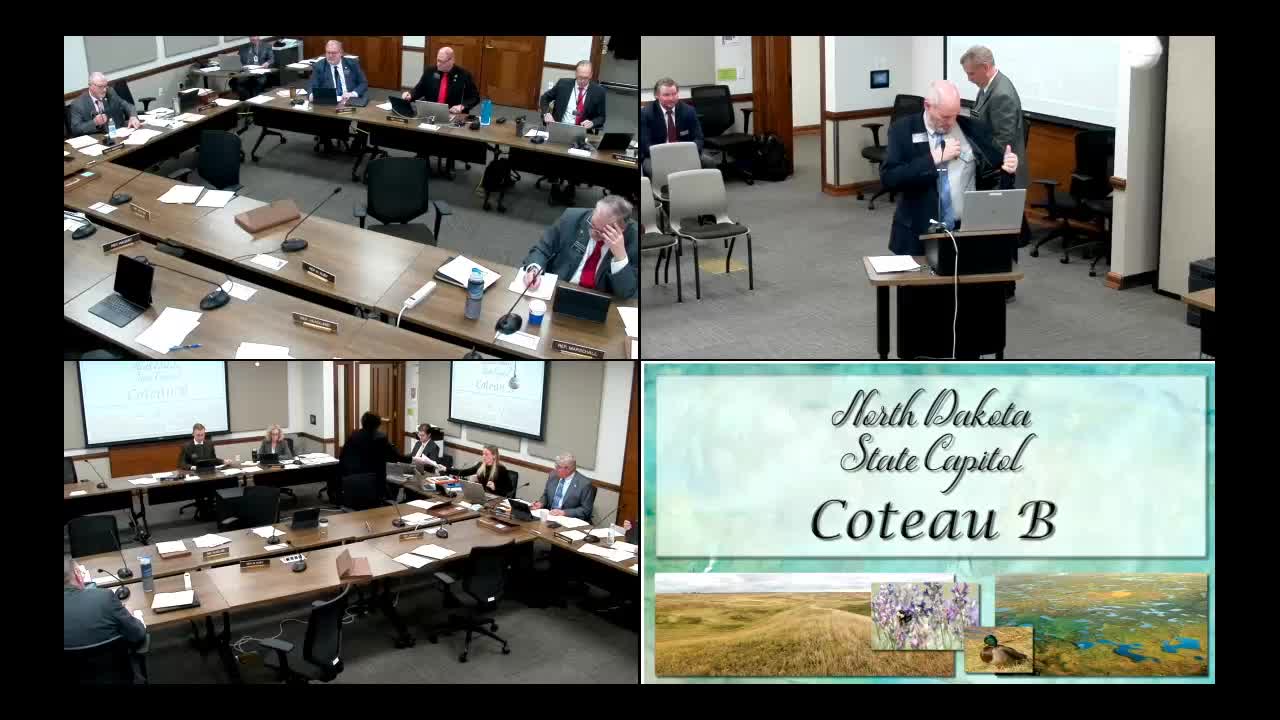Department of Water Resources, DOT and utilities oppose bill requiring wetland high‑water determinations; farm groups support talks
March 20, 2025 | Energy and Natural Resources, House of Representatives, Legislative, North Dakota
This article was created by AI summarizing key points discussed. AI makes mistakes, so for full details and context, please refer to the video of the full meeting. Please report any errors so we can fix them. Report an error »

Senator Larry Lueck introduced Senate Bill 23‑25, a proposal to require easement holders for non‑federal wetland areas to obtain determinations of each wetland’s ordinary high‑water mark and to manage water levels to that elevation. Sponsor remarks framed the bill as a tool to address persistent damage from standing water at roads, culverts and private property and to provide greater clarity for local infrastructure decisions.
Supporters from agricultural groups said the bill would create uniformity in wetland management and help resolve local disputes. Rachel Gross of the North Dakota Farm Bureau said modern aerial mapping and other tools could help establish high‑water marks and that the bureau was open to working through language and implementation concerns.
State agencies and other stakeholders opposed the bill as written. Aaron Carranza, director of the Department of Water Resources, said the department lacks staff, scientific expertise and statutory authority to make ordinary high‑water determinations for wetlands, warned the change would be an unfunded regulatory expansion and urged a fiscal note. He also said retroactive application to previously granted easements is ambiguous and legally risky and that directing easement holders to manage surface water when they do not control an outlet could produce complex downstream impacts.
The Department of Transportation told the committee the proposed retroactive determinations would complicate DOT mitigation banking and wetlands restoration work because ordinary high‑water mark methodology does not translate directly to the maximum pool or design elevations used in mitigation banks. The DOT also warned retroactive liability and the administrative burden could deter landowners from participating in mitigation easements.
Opposition also included utilities and electric cooperatives, which argued the language could create unintended liabilities and interfere with long‑established mitigation programs. North Dakota Farmers Union and North Dakota Agricultural Mitigation (NDAM) representatives said wetland mitigation banking already addresses many of the water‑management concerns and urged technical alignment rather than a statutory mandate.
Why it matters: SB 23‑25 would change who must determine and manage wetland elevations and could assign new liabilities and costs; state agencies said the bill, as drafted, would impose significant, unfunded administrative burdens and legal uncertainty that deserve further study.
Committee action: The Department of Water Resources recommended against passage as written and suggested the issue be worked through with stakeholders; no committee vote is recorded in the transcript.
Supporters from agricultural groups said the bill would create uniformity in wetland management and help resolve local disputes. Rachel Gross of the North Dakota Farm Bureau said modern aerial mapping and other tools could help establish high‑water marks and that the bureau was open to working through language and implementation concerns.
State agencies and other stakeholders opposed the bill as written. Aaron Carranza, director of the Department of Water Resources, said the department lacks staff, scientific expertise and statutory authority to make ordinary high‑water determinations for wetlands, warned the change would be an unfunded regulatory expansion and urged a fiscal note. He also said retroactive application to previously granted easements is ambiguous and legally risky and that directing easement holders to manage surface water when they do not control an outlet could produce complex downstream impacts.
The Department of Transportation told the committee the proposed retroactive determinations would complicate DOT mitigation banking and wetlands restoration work because ordinary high‑water mark methodology does not translate directly to the maximum pool or design elevations used in mitigation banks. The DOT also warned retroactive liability and the administrative burden could deter landowners from participating in mitigation easements.
Opposition also included utilities and electric cooperatives, which argued the language could create unintended liabilities and interfere with long‑established mitigation programs. North Dakota Farmers Union and North Dakota Agricultural Mitigation (NDAM) representatives said wetland mitigation banking already addresses many of the water‑management concerns and urged technical alignment rather than a statutory mandate.
Why it matters: SB 23‑25 would change who must determine and manage wetland elevations and could assign new liabilities and costs; state agencies said the bill, as drafted, would impose significant, unfunded administrative burdens and legal uncertainty that deserve further study.
Committee action: The Department of Water Resources recommended against passage as written and suggested the issue be worked through with stakeholders; no committee vote is recorded in the transcript.
View full meeting
This article is based on a recent meeting—watch the full video and explore the complete transcript for deeper insights into the discussion.
View full meeting
